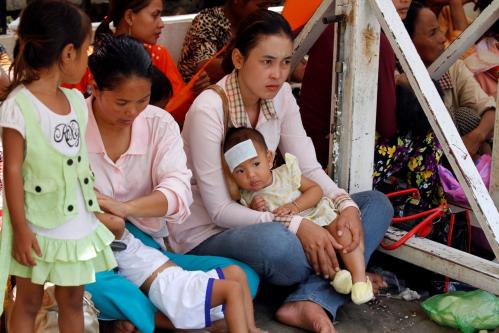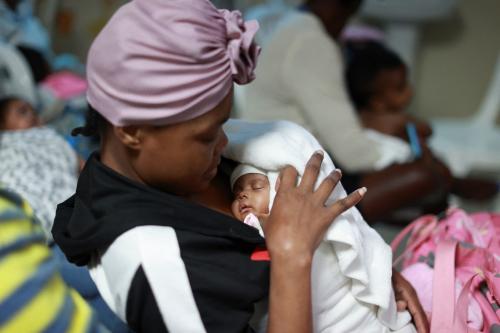The President’s Emergency Plan for AIDS Relief (PEPFAR) has provided billions of US tax dollars to expand HIV treatment, care, and prevention programs in sub-Saharan Africa. This investment has generated significant health gains, but much less is known about PEPFAR’s population-level economic effects. We used a difference-in-differences approach to compare employment trends between ten countries that received a large amount of PEPFAR funding (focus countries) and eleven countries that received little or no funding (control countries). We found that PEPFAR was associated with a 13 percent differential increase in employment among males in focus countries, compared to control countries. However, we observed no change in employment among females. In addition, we found that increasing PEPFAR per capita funding by $100 was associated with a 9.1-percentage-point increase in employment among males. This rise in employment generates economic benefits equal to half of PEPFAR’s cost. These findings suggest that PEPFAR’s economic impact should be taken into account when making aid allocation decisions.
Introduction
As of 2010, HIV/AIDS was the leading cause of death and disability among working-age adults in sub-Saharan Africa. Along with its devastating health consequences, the epidemic has had severe economic effects. By some estimates, it has reduced average economic growth rates in sub-Saharan Africa by 2–4 percent. 2 To combat the HIV/AIDs burden, the international community nearly tripled its total assistance for health in the 2000s. The largest component of the increased funding came from the US President’s Emergency Plan for AIDS Relief (PEPFAR).
PEPFAR was established in 2003 to provide funding for AIDS treatment, care, and prevention in countries devastated by the epidemic. From 2003 to 2013 Congress authorized $54 billion to fund programs in developing nations, mostly in sub-Saharan Africa. The bulk of PEPFAR assistance was aimed at increasing access to antiretroviral therapy (ART), and by 2013 the program had provided treatment to 6.7 million people infected with HIV.
The expansion of PEPFAR since 2003 has produced significant health returns, in the form of increased life expectancy and decreased mortality. However, most evaluations of PEPFAR have failed to measure its economic effect, although such effects are potentially important. Consequently, the economic impact of the provision of ART through PEPFAR is often overlooked in cost-effectiveness analyses and decisions about aid budgets.
Understanding the effect of PEPFAR on economic outcomes is important for US policy makers for several reasons. First, after PEPFAR was reauthorized in 2009, the US government required PEPFAR to transition from providing an emergency response to “strengthening the capacity of partner countries” and promoting sustainable country-level health programs. Positive economic impacts of PEPFAR would help in the effort to make countries capable of sustainably financing their own health systems.
Second, Africa represents a small but rapidly growing US export market, with US exports to sub-Saharan Africa increasing 250 percent in the past decade. This means that economic improvements in Africa can benefit the US economy indirectly.
Third, amid financial crisis and budget austerity in the United States, spending on aid for health and HIV treatment has stagnated. Given this budgetary environment, understanding the magnitude of PEPFAR’s impact beyond health benefits is imperative for the efficient allocation of scarce aid resources.
PEPFAR constitutes the “largest global health initiative focused on a single disease ever undertaken.” Nonetheless, there are no empirical evaluations of its economic impact at the population level. Previous evaluations of PEPFAR have synthesized results from previous microlevel studies; investigated PEPFAR’s effect on the provision of maternal health services; described operational capacity, management, and financing through qualitative research; or described the program’s financial flows. Other economic evaluations of the impact of ART have investigated effects on HIV patients through the use of modeled effects only or were specific to a single nation.
This study is the first to measure the impact of PEPFAR on employment outcomes throughout sub-Saharan Africa. It is also the first to explore the effect of any ART program on economic outcomes at the population level.
We used a difference-in-differences approach to measure changes in employment between a group of ten countries in sub-Saharan Africa that received a very large amount of PEPFAR funding (our focus countries) and a group of eleven countries in sub-Saharan Africa that received little or no PEPFAR funding (our control countries). This empirical strategy is consistent with previous work that found large reductions in mortality as a result of PEPFAR program implementation. The study results show the extent to which ART in particular and health aid in general can foster economic improvements within nations that receive PEPFAR support.
The Brookings Institution is committed to quality, independence, and impact.
We are supported by a diverse array of funders. In line with our values and policies, each Brookings publication represents the sole views of its author(s).



Commentary
PEPFAR funding associated with an increase in employment among males in ten Sub-Saharan African countries
June 9, 2015